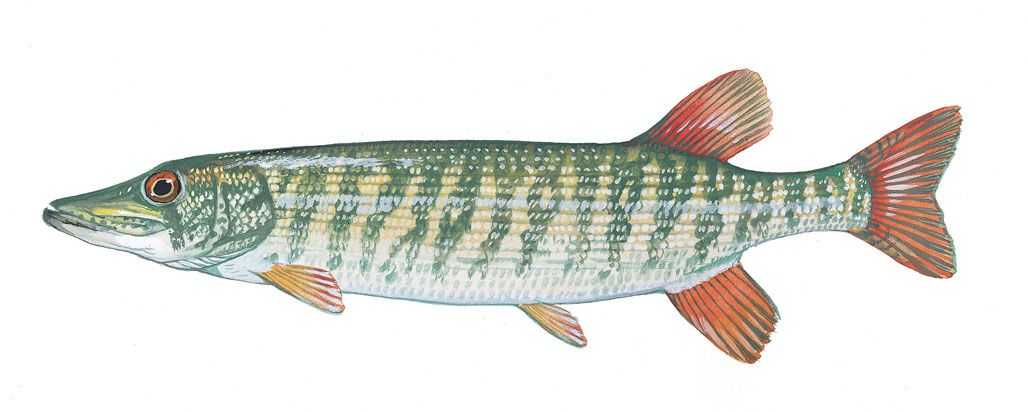Redfin Pickerel

Species Details
Esox Americanus
Esocidae
Esociformes
Lake, Stream, Swamp, Vegetation
1 - 2 lbs.
8" - 16"
Redfin Pickerel (Esox americanus americanus) Fish Description
The Redfin Pickerel (also known as redfin pike), highly associated with its cousins the chain pickerel and the grass pickerel, is a member of the pike family (Esocidae). What makes it different from its distant relatives are its gaudy red fins and very small size. There are two members of the pickerel: the Redfin Pickerel and the grass pickerel.
The snouts of Redfin Pickerels are shorter than their cousins’. They possess dark vertical bars on their bodies absent the chain-like markings found in the chain pickerel. These dark bars mark the area slightly below the eye extending downwards (to the base of the caudal fin). The Redfin Pickerels’ bodies are typically colored brown to cream, whereas their vertical barring is brown to olive or silvery-green. Their lower fins are reddish; their dorsal and tail fins have no dark markings.
Diet and Size
As an ambush predator, Red Pickerels wait for their smaller prey that comes within their range of attack among thickly vegetated areas. They feed on crayfish, smaller fishes, and insect larvae. Newly hatched Red Pickerels eat the eggs of insects and spawning fishes.
On average, the Redfin Pickerel measures around 5 to 9 inches. Some may reach around 11 inches. Redfin Pickerels are known to live up to 5 years, though some are reported to have survived until 8. Juvenile Redfin Pickerels grow rapidly. They develop their stripe marking at 2 years old.
Interesting Facts About the Redfin Pickerel
- Redfin Pickerels have very large eyes that help them find their prey.
- Since Redfin Pickerels have a polyandrous mating style, the females lay and scatter their eggs which are inseminated by multiple males who will release their milt or seminal fluid in the surrounding areas.
- The Redfin Pickerel is the smallest species of Pike in Connecticut.
Fishing Techniques
Fortunately for anglers, the IUCN declared the Red Pickerels is a species of Least Concern. However, they are still vulnerable to habitat loss, toxin exposure, biomagnification, and other kinds of environmental degradation.
Typically, Redfin Pickerels are elusive. To catch the smaller redfins, anglers may use dragging dip nets through heavy cover. A single drag using a long-handled dip net works well during summer. Anglers are discouraged from simply using a fishing rod when catching Redfin Pickerels. Instead, using a small live fish as bait with a bobber or float can be used. Anglers can fish the Redfin Pickerels in waters as shallow as two feet or even several inches! A size 8 barbless hook may be utilized.
Anglers may also opt to use minnow traps; this method takes time to perfect but it is highly effective. To do this, the trap must be placed in narrow stream passageways where any small fishes like the Redfin Pickerel would necessarily pass through.
Habitat and Distribution
Redfin Pickerels thrive in shallow (only as deep as 6-7 feet), clear freshwater streams, lakes, and swamps near the Atlantic slope. They are abundant in Massachusetts to Okeechobee Lake in Florida and St. Lawrence River in Canada, and the Pascagoula River in Mississippi. Redfin Pickerels are also aplenty in New Hampshire to Florida, as well as Connecticut. They also swim in all major drainages except in Housatonic, Thames, and other western watersheds. They like the clear freshwater areas with lots of vegetation or dense decaying organic matter; they hide in these places when waiting for prey.
They typically spawn from late February to early May. They migrate from the rivers and lakes and to small streams during the spawning season where the temperature ranges from 39 °F to 65 °F.







